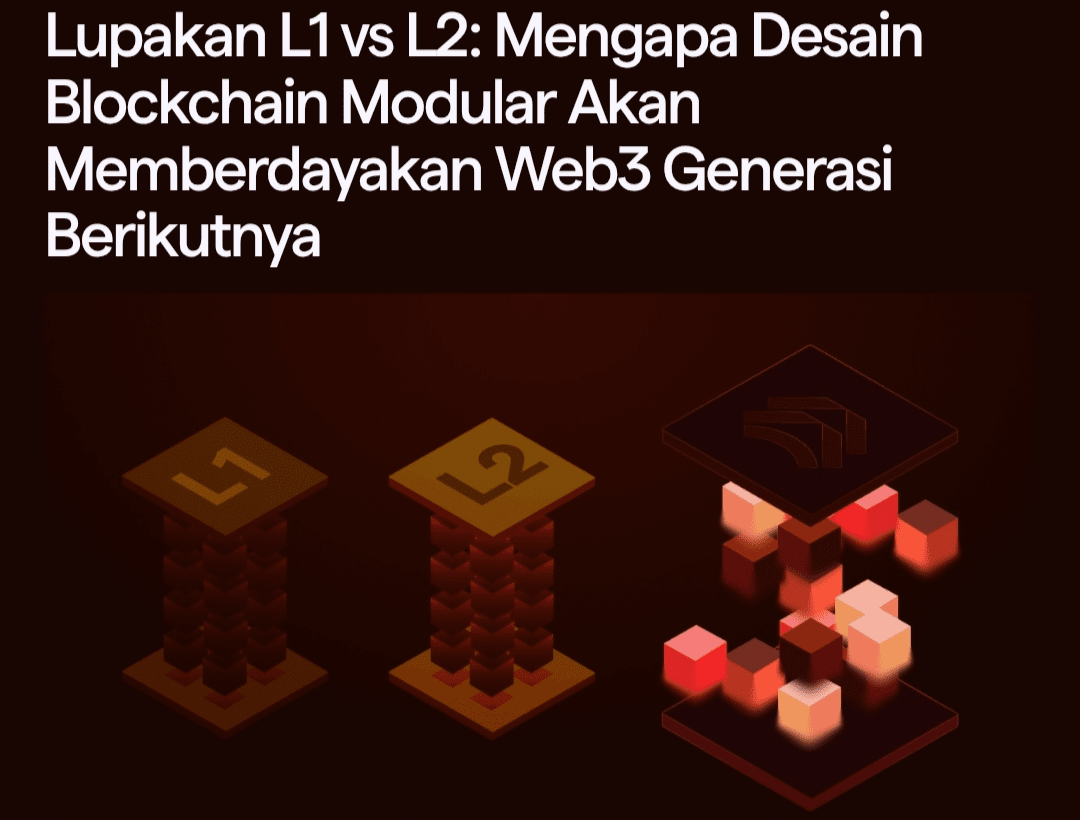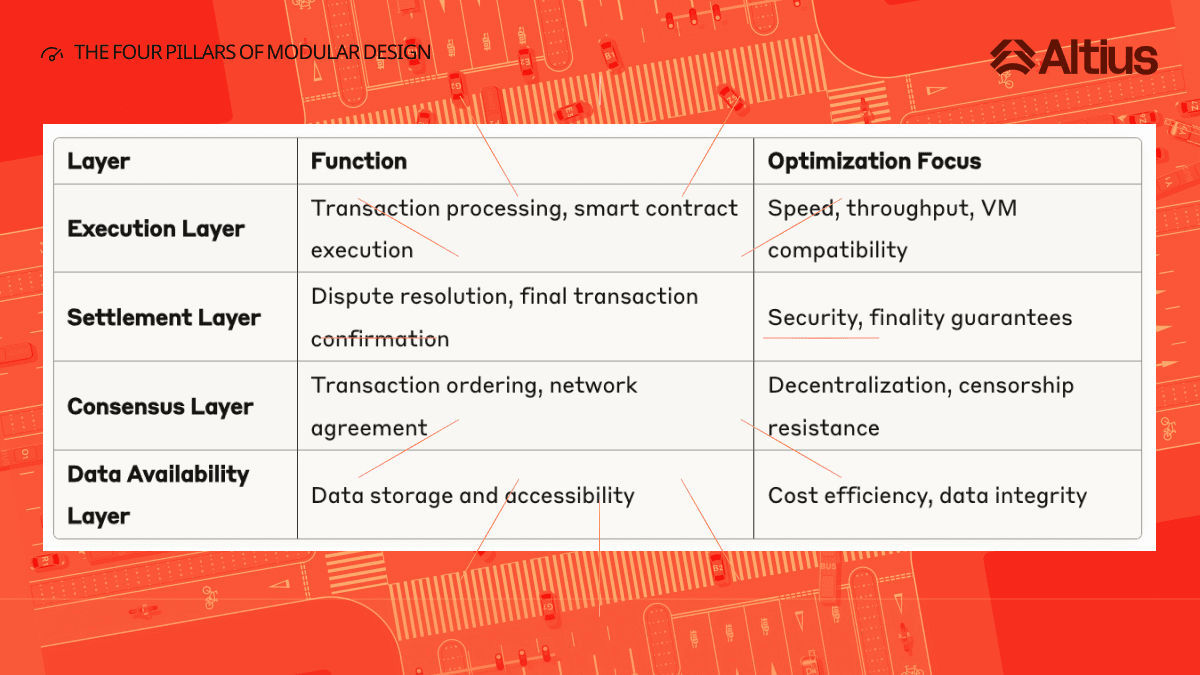
TLDR/Key Takeaways
The L1 vs. L2 debate is outdated — the future of Web3 is modular. Altius Labs technology is built with this narrative at its core.
Modular blockchain design separates execution, consensus, and data availability, allowing for greater scalability and flexibility.
Rather than choosing between monolithic L1 or scalable L2, builders can now assemble infrastructure built specifically.
A modular-first architecture will determine how applications scale securely, flexibly, and with far fewer compromises.

The blockchain space has been trapped in an endless L1 vs. L2 debate for years. Should you build on a fast but centralized Layer 1? Or accept the complexity of Layer 2 merging for better scalability? Here's the issue: you are asking the wrong question entirely.
While the crypto community debates which solution is 'better', fundamental changes are taking place beneath the surface. Modular blockchain architecture is quietly revolutionizing how we think about Web3 infrastructure, rendering the traditional L1 vs. L2 framework obsolete.
At Altius Labs, we have witnessed this transformation firsthand. Our modular execution stack does not force developers to choose between competing blockchain paradigms. Instead, this stack enables them to plug high-performance execution into any blockchain infrastructure, whether L1, L2, or application chains.
The future is not about choosing sides in the L1 vs. L2 debate — it is about assembling the perfect blockchain stack for your specific needs.
Why the L1 vs L2 Framework is Fundamentally Flawed
Current blockchain discourse treats scalability as a zero-sum game. You get the security and decentralization of Layer 1 like Ethereum, or you sacrifice some of those properties for the speed of Layer 2 solutions like Arbitrum or Optimism.
This binary thinking stems from the era of monolithic blockchains, where each blockchain had to handle four critical functions simultaneously:
Execution: Processing transactions and smart contracts
Consensus: Agreeing on the order and validity of transactions
Data Availability: Ensuring transaction data remains accessible
Settlement: Completing transactions and resolving disputes
Monolithic blockchains combine all functions in a single layer, whereas modular blockchains divide the system into smaller, specialized parts. This creates inherent limitations that cannot be fully overcome by any optimizations.
Think of it this way: asking whether Ethereum or Polygon is 'better' is like asking whether a Swiss Army knife or a kitchen knife is superior. The answer entirely depends on what you want to achieve.
Scalability Trilemma Trap
The famous blockchain trilemma — the idea that you can only optimize two of three: scalability, security, and decentralization — exists because we have thought in monolithic terms. Bitcoin's focus on decentralization and security automatically excludes scalability, while chains with high throughput often sacrifice some measure of decentralization and security.
But what if you didn't have to make that choice at all?
Entering Modular Blockchain Design: The Third Way
Instead of having a single blockchain perform all roles, modular architecture separates these core functions into different layers or specialized chains. This separation allows each layer to optimize its role specifically, drastically improving scalability and flexibility.
Modular blockchain architecture breaks the traditional blockchain stack into several specialized layers:

This separation creates something revolutionary: composable infrastructure. Instead of being confined to a single blockchain's trade-offs, developers can mix and match the best solutions for each layer.
How Modular Architecture Solves Real Problems
Let's discuss practicalities. Say you are building a high-frequency DeFi application. In a monolithic world, you would face an impossible choice:
Choose Ethereum: Get security and decentralization, but face high costs and slow execution
Choose a fast L1: Get speed, but sacrifice decentralization and composability
Choose L2: Get some scalability, but add complexity and potential security assumptions
With modular blockchain design, you can:
Use Ethereum for consensus and settlement (maximum security)
Leverage specialized data availability layers like Celestia (cost-effective storage)
Connect high-performance execution layers like Altius (gigagas throughput per second)
Suddenly, you are no longer making trade-offs — you are optimizing each component.
Altius Labs Approach: The Edge of Execution Layer
At Altius Labs, we focus on solving one piece of the modular puzzle exceptionally well: the execution layer. Our approach demonstrates why modular blockchain architecture represents the future of Web3 infrastructure.
Beyond the VM Wars
The current ecosystem is fragmented across various virtual machines — EVM, WASM, SVM, and others. This creates another false choice: which VM should you build on?
Our VM-agnostic execution stack completely removes this decision. Starting with EVM compatibility, we can quickly expand support for other virtual machines, enabling true blockchain interoperability at the execution level.
Performance Without Compromise
Traditional blockchain execution faces fundamental bottlenecks. Every transaction must be processed sequentially, creating a natural throughput limit. Our parallel execution architecture identifies transaction dependencies at the instruction level, enabling massive performance increases while maintaining security guarantees.

Plug-and-Play Integration
Perhaps most importantly, our modular execution layers integrate seamlessly with existing blockchain infrastructure. You don’t need to migrate to a new chain or require specialized hardware. This is true plug-and-play blockchain scalability.
Real-World Impact: Modular Design in Action
The shift toward modular blockchain architecture is not just theory — it is happening right now. Manta Network has emerged as one of the leading modular blockchains in 2024, distinguished by its strong focus on privacy, scalability, and interoperability.
Case Study: Multi-Chain Composability
Consider complex DeFi protocols that need:
Executing high-frequency trading (execution layer optimization)
Establish a final position on Ethereum (settlement layer security)
Cost-efficient storage of price feed data (data availability efficiency)
Coordinating across multiple chains (consensus layer reliability)
In the old paradigm, this required complex bridges, multiple integrations, and significant security assumptions. With modular blockchain design, each layer can be optimized independently while maintaining seamless composition.
Developer Experience Revolution
Modular architecture encourages interoperability with external systems, fostering collaboration and integration with other protocols. This creates a fundamentally different developer experience:
Choose Your Adventure: Select the best tools for each layer
Future-Proof Architecture: Upgrade individual components without rebuilding everything
Reduced Complexity: Focus on application logic rather than infrastructure compromises
Enhanced Composability: Built on specialized and optimized components
Why Modular Will Win: Network Effects
The power of modular blockchain design becomes clear when you consider network effects. In the monolithic era, each blockchain competed separately. Success meant pulling users and liquidity from competitors.
Modular architecture flips this dynamic. Success in one layer enhances the entire ecosystem:
Better execution layers make all applications faster
More efficient data availability reduces costs for everyone
Enhanced consensus mechanisms improve security across the stack
Enhanced settlement layers provide stronger finality guarantees
This creates positive growth, not zero-sum competition.
Web3 Cambrian Explosion
We are entering what can be termed the 'Cambrian Explosion' of Web3 infrastructure. Just as web infrastructure evolved from local servers to cloud servers, the decentralized web is evolving from monolithic blockchains and isolated consensus layers to modular application-specific chains with shared consensus layers.
Just as cloud computing enabled an explosion of web applications by providing composable infrastructure services, modular blockchain architecture enables a new generation of Web3 applications that were previously impossible.
Deep Technical Dive: How Modular Actually Works
Let's examine how modular blockchain design works at a technical level, using our experience at Altius Labs as a practical example.
Execution Layer Specialization
In a modular blockchain structure, the execution layer is independent of the underlying data availability and consensus layers. This allows nodes to execute transactions separately rather than performing all transactions to test validity within a limited space or block.
This separation allows for several key optimizations:
Parallel Processing Architecture
Our resolver components transform bytecode into Static Single Assignment format, identifying transaction dependencies at the instruction level. Instead of re-executing the entire conflicting transaction, we only reprocess the conflicting instructions, significantly boosting throughput.
State Sharding for Scalability
State is divided into multiple shards that can run on commodity hardware. Each shard is stored across various nodes, enabling parallel processing, concurrent read/write operations, and efficient state updates.
Incentive Alignment
Our coordinator components reward developers for writing more efficient code. Efficient coding patterns result in fewer conflicting occurrences, creating a natural incentive structure that enhances overall system performance.
Cross-Layer Communication
The magic of modular blockchain architecture lies in how these specialized layers communicate. Instead of direct integration, layers interact through standard interfaces, allowing:
Atomic Composability: Transactions can span multiple layers while maintaining atomicity
Asynchronous Processing: Different layers can operate at their optimal speeds
Error Isolation: Issues in one layer do not propagate throughout the system
Overcoming Modular Challenges
Modular blockchain design is not without challenges. The increasing complexity of coordinating multiple layers creates new attack vectors and user experience considerations.
Security Considerations
Achieving modularity requires a balance between scalability, security, and decentralization. Key security considerations include:
Cross-layer dependencies: Ensuring failure of one layer does not disrupt others
Interface Security: Protecting communication channels between layers
Composability Risks: Managing security as multiple components interact
User Experience Complexity
Modular systems can create complexity for end users who need to understand multiple layers. However, this is primarily a challenge of tooling and abstraction, similar to how users don’t need to understand TCP/IP to use the internet.
The Way Forward: The Inevitable Modular Future
The shift towards modular blockchain architecture is not just a technical evolution — it is an inevitable progression towards specialization and efficiency. Modular blockchains enhance scalability and efficiency by dividing tasks among specialized layers, unlike monolithic chains that handle everything.
Industry Adoption Trends
Major blockchain projects have adopted modularity:
The Ethereum roadmap emphasizes scaling centered around rollups
New Layer 1s are built with a modular-first architecture
Enterprise adoption focuses on composable blockchain solutions
Altius Vision
At Altius Labs, we are building a future where blockchain scalability is no longer a limitation but a baseline expectation. Our modular execution layers are just the beginning of this transformation.
By separating execution from other blockchain functions, we allow the ecosystem to focus on what matters most: building unique and distinct applications that deliver real value to users.
Conclusion: Beyond the L1 vs. L2 Debate
The L1 vs. L2 debate has reached its conclusion at the early stage of blockchain evolution, but now it is time to move beyond just binary thinking. Modular blockchain design offers a third way — a way that does not impose impossible choices between scalability, security, and decentralization.
The future of Web3 belongs to builders who embrace composable infrastructure, blockchain interoperability, and custom optimizations. Rather than choosing between existing solutions, they will assemble the perfect stack for their specific needs.
At Altius Labs, we are not just building technology — we are pioneering the infrastructure that will support the next generation of Web3 applications. Our modular execution layers are designed to integrate seamlessly with any blockchain, providing gigabyte-per-second performance without sacrificing decentralization or security.
The question is not whether you should build on L1 or L2. The question is: what will you build when infrastructure limitations no longer hold you back?
Ready to explore modular blockchain architecture for your project? Visit Altius Labs to learn how our execution layers can transform the performance of your Web3 applications, or join the discussion on the future of blockchain scalability in our community.
